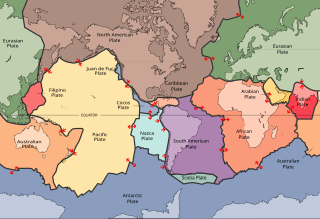
The mechanically rigid outer layer of the Earth, the lithosphere, is broken into pieces called tectonic plates. These plates are rigid segments that move in relation to one another at one of three types of plate boundaries: Convergent boundaries, at which two plates come together, Divergent boundaries, at which two plates are pulled apart, and Transform boundaries, in which two plates slide past one another laterally. Earthquakes, volcanic activity, mountain-building, and oceanic trench formation can occur along these plate boundaries.[67] The tectonic plates ride on top of the asthenosphere, the solid but less-viscous part of the upper mantle that can flow and move along with the plates,[68] and their motion is strongly coupled with patterns convection inside the Earth's mantle.
As the tectonic plates migrate across the planet, the ocean floor is subducted under the leading edges of the plates at convergent boundaries. At the same time, the upwelling of mantle material at divergent boundries creates mid-ocean ridges. The combination of these processes continually recycles the oceanic crust back into the mantle. Because of this recycling, most of the ocean floor is less than 100 million years in age. The oldest oceanic crust is located in the Western Pacific, and has an estimated age of about 200 million years.[69][70] By comparison, the oldest dated continental crust is 4030 million years old.[71]
| A map illustrating the Earth's major plates. | Plate name | Area 106 km² |
|---|---|---|
| African Plate[note 10] | 78.0 | |
| Antarctic Plate | 60.9 | |
| Australian Plate | 47.2 | |
| Eurasian Plate | 67.8 | |
| North American Plate | 75.9 | |
| South American Plate | 43.6 | |
| Pacific Plate | 103.3 |
Other notable plates include the Indian Plate, the Arabian Plate, the Caribbean Plate, the Nazca Plate off the west coast of South America and the Scotia Plate in the southern Atlantic Ocean. The Australian Plate actually fused with Indian Plate between 50 and 55 million years ago. The fastest-moving plates are the oceanic plates, with the Cocos Plate advancing at a rate of 75 mm/yr[73] and the Pacific Plate moving 52–69 mm/yr. At the other extreme, the slowest-moving plate is the Eurasian Plate, progressing at a typical rate of about 21 mm/yr.[74]



No comments:
Post a Comment